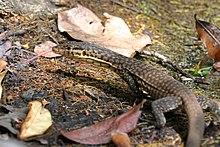
Monitor lizards are lizards in the genus Varanus, the only extant genus in the family Varanidae. They are native to Africa, Asia, and Oceania, and one species is also found in the Americas as an invasive species. About 80 species are recognized.

The Nile monitor is a large member of the monitor family (Varanidae) found throughout most of Sub-Saharan Africa, particularly in drier regions, and along the Nile River and its tributaries in East Africa. Additionally, there are modern, invasive populations in North America. The population found in West African forests and savannahs is sometimes recognized as a separate species, the West African Nile monitor. While it is dwarfed by its larger relatives, such as the Komodo dragon, the Asian water monitor or the crocodile monitor, it is still one of the largest lizards in the world, reaching Australia’s perentie in size. Other common names include the African small-grain lizard, as well as iguana and various forms derived from it, such as guana, water leguaan or river leguaan.
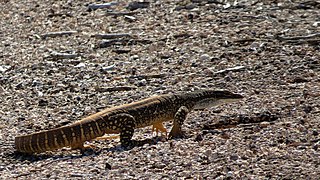
The sand goanna, also known commonly as Gould's monitor, the racehorse goanna, and the sand monitor, is a species of large Australian monitor lizard in the family Varanidae.

The mangrove monitor, mangrove goanna, or Western Pacific monitor lizard is a member of the monitor lizard family with a large distribution from northern Australia and New Guinea to the Moluccas and Solomon Islands. It grows to lengths of 3.5 to 4 ft. It is also known as wbl yb in the Kalam language of Papua New Guinea.

The yellow-spotted monitor, also known as the Argus monitor, is a monitor lizard found in northern and western regions of Australia and southern New Guinea.

The spiny-tailed monitor, also known as the Australian spiny-tailed monitor, the ridge-tailed monitor the Ackie dwarf monitor, and colloquially simply ackie monitor, is an Australian species of lizard belonging to the genus of monitor lizards (Varanus).
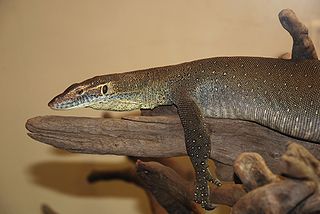
Mertens' water monitor, often misspelled Mertin's water monitor, is a species of monitor lizard. The species is endemic to northern Australia, and is a wide-ranging, actively foraging, opportunistic predator of aquatic and riparian habitats. It is named after German herpetologist Robert Mertens.
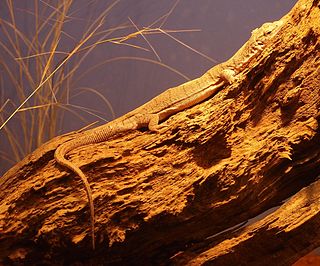
The pygmy mulga monitor, also known commonly as Gillen's monitor or just the mulga monitor, is a species of lizard in the family Varanidae. The species is endemic to Australia.

The Kimberley rock monitor is a medium-sized species of monitor lizard in the family Varanidae. The species is native to Northern Australia. Also known commonly as Glauert's monitor and the Kakadu sand goanna, it belongs to the subgenus Odatria.

The Rosenberg's monitor is an Australian species of varanid reptile found in southern regions of the continent. They are large and fast predators with rugged bodies and long tails, having a combined length up to 1.5 metres, that will consume any smaller animal that is pursued and captured or found while foraging. They occur in the Australian Capital Territory, New South Wales, South Australia, Victoria, where it may be rare or locally common, and more frequently observed in Western Australia, where it is sometimes abundant.
The black-spotted ridge-tailed monitor, also called commonly the black-spotted spiny-tailed monitor, the lemon-throated monitor, the northern ridge-tailed monitor, Whites monitor, and the yellow-throated monitor, is a subspecies of lizard in the family Varanidae. The subspecies is native to Australia's tropical Northern Territory. It is listed as Least Concern on the IUCN Red List as it is considered common and not threatened. It was first described in 1987. It is also known as White's dwarf goanna.

The blue-tailed monitor, blue-tailed tree monitor or Kalabeck's monitor, is a monitor lizard of the Varanidae family. It belongs to the V. doreanus group of the subgenus Euprepiosaurus.

Dumeril's monitor is a species of lizard in the family Varanidae. The species is endemic to Southeast Asia.
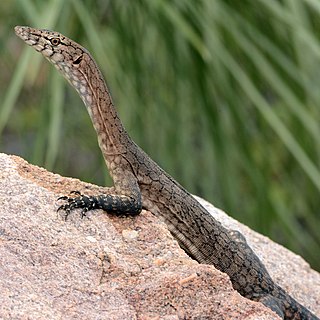
The black-palmed rock monitor is a member of the Varanidae family found in Australia. Also known as the twilight monitor or the long-tailed rock monitor, it is a member of the subgenus Odatria, and is found in the northern part of Australia in the Northern Territory and Western Australia, as well as Queensland. Specifically, its distribution extends from Mount Isa in the east to the Kimberleys in the west. Its habitat is areas of rock escarpment, and large populations may be found in small areas.
Varanus keithhornei, commonly known as the canopy goanna, Keith Horne's monitor, blue-nosed tree monitor, or Nesbit River monitor, is a species of monitor lizards native to northeast Australia. It is a member of the Varanus prasinus species group.

Kings' monitor, also known commonly as Kings' goanna, Kings' rock monitor and pygmy rock monitor, is a small species of monitor lizard in the family Varanidae. The species is native to Australia.

The marbled water monitor, also known commonly as the Philippine water monitor, is a large species of monitor lizard in the family Varanidae. The species is endemic to the Philippines.
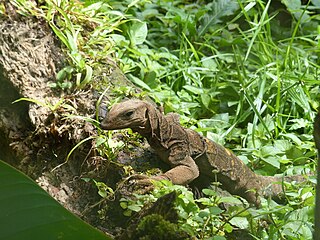
Varanus spinulosus, the Solomon Island spiny monitor, Isabel monitor, or spiny-neck monitor, is a species of monitor lizard. It is endemic to the Solomon Islands archipelago and is also known from Santa Isabel Island, San Jorge Island and Bourgainville Island.
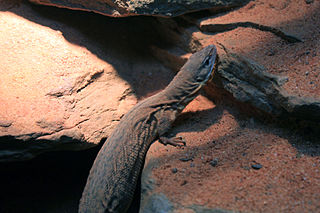
Storr's monitor is a species of monitor lizard in the family Varanidae. The species is endemic to Australia.

Odatria, commonly known as dwarf monitors, consists of small monitor lizards found in Australia and Indonesia. Species in this subgenus include the smallest monitor species in the world, the tiny 16 gram Dampier Peninsula monitor, but also includes some more medium sized species such as the 240 gram black-palmed rock monitor.
